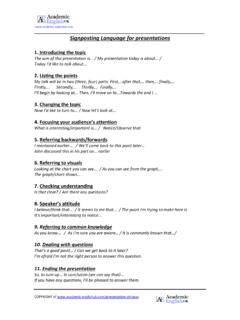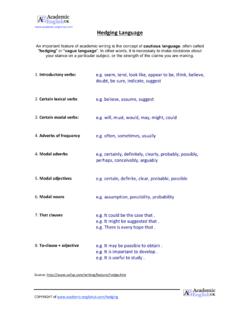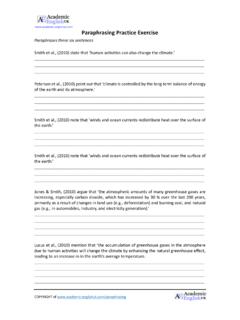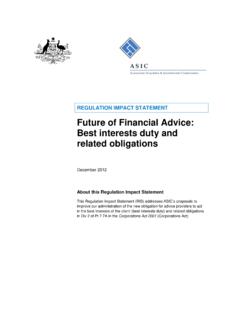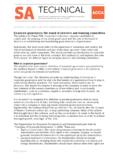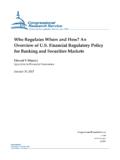Transcription of The Causes of the 2008 Financial Crisis - Academic English UK
1 _____ COPYRIGHT of The Causes of the 2008 Financial Crisis Summary Writing Copyright: These materials are photocopiable but we would appreciate it if all logos and web addresses were left on materials. Thank you. UK _____ COPYRIGHT of Student Two types of lesson Lesson#1: [Easy] ** [B2/C1] 1. Try to predict the content of text / write down key terms / ideas 2. Read text check words and meanings with a dictionary 3. Fill in the outline to identify key points and support 4. Write the summary only one paragraph (200-250 words) 5. Check key points & model answer (try to achieve 4 key points and 4 support points) 6. Answer critical thinking questions & check answers Lesson #2: [Hard] ** [C1] 1. Read text no dictionary 2. Fill in outline to identify key points and support / or take notes from text 4. Write the summary only one paragraph (200-250 words) 5. Check key points & model answer (try to achieve 4 key points and 4 support points) 6.
2 Answer critical thinking questions & check answers Teacher Two types of lesson Lesson#1: [easy] ** [B2/C1] 1. Give out text a week /day before the test students read, check vocabulary and meaning. 2. Test day give out a new copy of text and summary question 3. Set 1 hour to read text, take notes and write the summary 4. The summary only one paragraph (200-250 words) 5. Feedback1: take in and mark [use correction code*] 6. Feedback2: give out key points & model answer 7. SUMMARY: Should contain at least 4 main ideas with support see Summary Key Points 8. Extra: Answer critical thinking questions / group discussion (30 minutes) Correction code*: Lesson #2: [hard] ** [C1] 1. Set 1 hour to read text and write the summary 2. The summary only one paragraph (200-250 words) 3. Feedback1: take in and mark [use correction code*] 4. Feedback2: give out key points & model answer 5. SUMMARY: Should contain at least 4 main ideas with support see Summary Key Points 6.
3 Extra: Answer critical thinking questions / group discussion (30 minutes) _____ COPYRIGHT of The Causes of the Financial Crisis 2008 C. Wilson [2017] 1) In 2008 the world experienced the worst Financial Crisis since the Great Depression (1930s). The severe magnitude of the Financial disaster became fully evident towards the end of 2007, it had, however begun years earlier through what many claim was the main factor in the crash; sub-prime mortgage lending. The Financial Crisis of 2007-08 and the aftershocks of the US subprime mortgage Crisis of 2007-09 is now considered to be 'The Great Recession'. The US Financial Crisis Inquiry Commission [FCIC] (2011) reported the Crisis was avoidable and was caused from widespread failures in regulation of Financial institutions and the reckless actions in risk and borrowing. It concluded that key governmental policy makers were ill-prepared, lacked understanding and accountability in the Financial systems they oversaw.
4 This article will examine how subprime mortgage lending led to the Great Recession. 2) Towards the end of the 1990s property purchases began to rise. With such growth, lending money for house buying became a profitable business in both mortgages and remortgaging. Traditionally, the house buyer saves up a deposit (down payment usually between 10% of the house cost), and contacts a bank or mortgage broker, who connects them to a lender, who in turn provides a mortgage based on the grounds of specific criteria (permanent employment, no previous Financial defaults (a positive credit-score), and the repayment plan is achievable). This is characterized as a Prime-mortgage and the level of risk in lending is extremely low. 3) Throughout 2000 as home ownership became more popular and house prices rose significantly (1997 2006 house price rose by 124% in the US and 186% in the UK (US Spindices, 2016)), lenders began to securitise these mortgages into mortgage-backed securities (MBS) and Collateralized Debt Obligations (CDOs) and then sold them to the investment banking sector.
5 These mortgages were rated by credit agencies into three areas, safe , ok and risky , and then sold on to the shadow banking Sector or investors, non- depository bankers, and hedge funds respectively. However, the Prime mortgage market began to become saturated due to those who qualified had one. 4) Therefore, sub-prime mortgage lending was introduced in 2002/3 based on the presumption that as house prices continue to rise, if a borrower defaults on payment the lender reprocesses the house as equity. Lenders begin to add risk to these new mortgages in that no deposit, no proof of income, or no documents were required to obtain a mortgage. An estimated $ trillion loans were issued to homeowners with bad credit and undocumented incomes between 2002-2007 (FCIC, 2011), and with such a rise deregulation of banking policy occurred to include fraudulent automated underwriting processes and credit agencies' standards falling. At the same time 'predatory lending' offered loans at low interest rates or Adjustable Rate Mortgage (ARM) rates, where the consumer was unaware of the contract and associated rates (Krugman, 2009).
6 The sub-prime mortgage process actively encouraged a rise in house price and a phenomenon known as the 'housing bubble', where house price rises much faster than wages making housing unaffordable or people borrowing more than they can repay. 5) The shadow banking sector of Investment bankers, hedge funds and insurance firms all bought into the highly profitable world of sub-prime mortgage backed securities. These highly profitable credit instruments (CDOs), were traded internationally through derivatives and foreign exchange trading and spread across the global Financial community. By 2006, 80% of mortgages were subprime loans with an estimated value of $ trillion (FCIC, 2011) shadow banking often referred to as parallel banking , were not subject to the same banking regulatory controls, these institutions were vulnerable as they borrowed short-term in liquid markets to purchase long term, illiquid and _____ COPYRIGHT of risky assets.
7 This meant disruptions in credit markets would create rapid deleveraging, selling long term assets at depressed prices. 6) Interest rates began to rise in 2007, and this was the beginning of the end. The default rates began to increase with many borrowers unable to meet the monthly payments, this in turn meant that MBS and CDOs began to lose value with higher default rates. Concurrently, the housing bubble burst and house prices fell 40% (FCIC, 2011), leaving many people in negative equity. However, the most serious effect was a Crisis of liquidity and trust that occurred across banks. Lehman Brothers went bankrupt and many more (Merrill Lynch, AIG, Freddie Mac, Fannie Mae, HBOS, Royal Bank of Scotland, Bradford & Bingley, Fortis, Hypo and Alliance & Leicester) were on the verge of bankruptcy and needed to be bailed out by Governments. In fact, 21 Banks and 61 hedge funds had been forced to declare bankruptcy in the US alone (Morris & Song, 2008).
8 The remaining banks rose interest rates and stopped lending money, this became known as the 'Credit Crunch'. 7) Since 2008, a number of measures have been created in response to rectify the problems. These include Financial rescue plans, central bank s monetary policies of lowering interest rates, and Governmental public stimulus packages. There are calls for improved market regulation and supervision, which has been met through the Dodd Frank Act (Krugman, 2009). This was the largest reform of the banking sector since WW2. In addition, a new global Financial system regulated by the IMF is being implemented, who should have a broader role in the regulatory system of the world economy. 8) Overall, the Financial Crisis of 2008 was not just the sub-prime mortgage lending sector. There are a number of other contributing factors that this article has not discussed, but primarily fraudulent greedy banking practice seems to lie at the heart of it.
9 To identify who is exactly to blame is incredibly difficult because the results of toxic assets from fraudulent underwriting processes, easy credit conditions, predatory lending, deregulation and over-leveraging all had a significant effect on creating one of the biggest crashes of all time. It seems that everyone was responsible, from government s inability to regulate innovative banking practice, Economists unable to forecast economic collapse, Financial institutions exploiting the complexity of MBS and CDOs and even homeowners taking on loans they were unable to pay back. The questions that exist, however, are whether it will happen again and are the measures in place sufficient to control and regulate banking practice. [1003 words] Reference List Krugman, P. (2009). The Return of Depression Economics and the Crisis of 2008. NY. Norton Company Limited. Morris, S. and Song H, S. (2009). Financial Regulation in a System Context.
10 Brookings Papers on Economic Activity, 2008(2), Available at: ~smorris/ [Accessed 21 Jan. 2017]. The Financial Crisis inquiry report [FCIR]: final report of the National Commission on the Causes of the Financial and Economic Crisis in the United States. (2011). Choice Reviews Online, [online] 48(12), Available at: [Accessed 18 Jan. 2017]. US (2016). S&P Core Logic Case-Shiller National Home Price NSA Index - S&P Dow Jones Indices. [online] Available at: [Accessed 22 Jan. 2017] _____ COPYRIGHT of Outline: Summary note-taking take notes on the key points of the article 1) main idea: Support: 2) main idea: Support: 3) main idea: Support: 4) main idea: Support: 5) main idea: Support: _____ COPYRIGHT of 6) main idea: Support: 7) main idea: Support: 8) main idea: Support: _____ COPYRIGHT of Summary Key Points ANSWERS A good summary should have 4 main ideas and 2 points of support for each main idea 1) main idea: Financial Crisis Background Support: 2008 = Great Depression (1930s).
